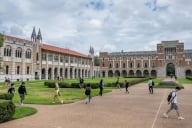You have /5 articles left.
Sign up for a free account or log in.
Many colleges have special orientation programs, prior to those offered for all entering students, for those who are from minority groups. The idea is that minority students entering a predominantly white college benefit from talking about the issues they may face, and connecting with fellow minority students and with groups on campus that help them. The programs have also been criticized over the years -- and sometimes abandoned as a result -- for segregating students at the start of college.
Mount Holyoke College, which has for many years had a voluntary program for minority students in advance of the general orientation, plans this year to start a special section at the same time, also voluntary, for white students from the United States. (There is also a mandatory pre-orientation for international students.) Over three and a half days, the white and minority students will spend time separately and together, talking about race, before they join the four-day program for all new students.
Joyce Holl, executive director of the National Association of Orientation Directors, said that she had never before heard of a college creating a program at orientation for white students. She said she believed a minority of orientation programs have special options for minority students, and that the majority of orientations are -- in their entirety -- for all students.
As Mount Holyoke's plans have been discussed on some Web sites for college students, reaction has been mixed, but some of those reacting appear to think that the idea is to keep minority and white students completely apart. Elizabeth Braun, dean of students at the college, said that the reality is that that two groups will probably spend more than half of the program time together, but will also have time to meet separately as white and minority students.
"This comes from our larger institutional commitment to diversity, and really figuring out students' opportunities to engage with that diversity." (About one third of students at the college are either from outside the United States or are members of minority groups.)
Braun said that the idea of creating the section of orientation for white students came from a series of programs at the college that involve encouraging students to talk about tough issues across racial and ethnic lines. The new pre-orientation program -- with its tracks for minority and white students -- will have the name: "Promoting Intercultural Dialogue and Creating Inclusion." Braun said that led to the decision to add the white section. "In order to have the pre-orientation inclusive, we needed to invite U.S. white students to participate," she said.
While Braun said specific plans are still being developed, she envisions that the first day of the program would have the groups in separate sessions, "exploring their own racial identity and thinking about power and privilege." Then the groups will have joint and separate programs. "We're trying to balance opportunities for self-reflection with creating your connections."
Braun said that the college will particularly seek to recruit to the special orientation white students "with an interest in anti-racism." In the regular orientation and throughout college, Braun said, others forms of difference will also be explored, including gender, class, religion and sexuality. "Different students have different unique perspectives," she said.
The new program, which Braun stressed was voluntary and a pilot, could be changed in the future. But she said she viewed this as a valuable alternative to eliminating special orientations for minority students. "It's really important to us to continue to value what is absolutely necessary" for minority students, she said.








